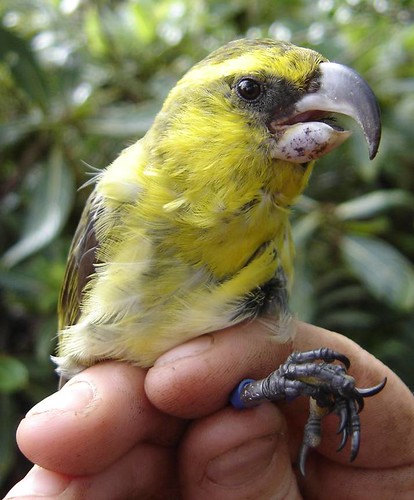5 Endangered Species You Could Hold in Your Hand

Photo by iStockphoto/irin717
Picture an endangered species in your head. Is it a tiger? Panda? Wolf? Regardless of what it is, it's probably bigger than a breadbox. Large, majestic animals catch the headlines, and are certainly worthy of attention, but the vast majority of species on Earth are itty-bitty. And while they may be small in stature, little animals have a big impact, forming the base of the food chain that supports all other life. Many of these palm-size-or-smaller beasties are just as endangered as tigers and pandas, and are much more likely to be hanging on in small parcels of protected land. So let's have a round of applause for the little guys, and enjoy this sampler of endangered species you could hold in your hand.

Maui Parrotbill (Pseudonestor xanthophrys)
Although this bird was probably never very common, the Maui parrotbill has a beak that really stands out in a crowd. This sharply hooked bill is used to pry insect larvae from their hiding places under tree bark. Slow to reproduce and needing a 20-acre territory for each pair of 6-inch birds, only around 500 individuals survive, all in two reserves on the Hawaiian island of Maui. Diseases spread by mosquitoes, predation by mongoose and rats, and habitat-munching goats and pigs (all of which are introduced to Maui) have decimated their populations. Many researchers agree that to ensure this species' existence, other parts of the island must be protected from the invaders, and allowed to regrow.
Lesser Long-nosed Bat (Leptonycteris yerbabuena)
These cute leaf-nosed bats are only three inches long, but have a huge role to play in the life cycle of iconic desert plants such as the saguaro cactus and agave. Not only do they pollinate the plants when they migrate north in summer, but they also eat cactus fruit and spread the seeds. Without little bats to pollinate their night-blooming flowers, the giant cacti would have a hard time reproducing. The bat in the picture has a radio transmitter on its back, part of a study to see how far the bats travel into urban areas looking for food. Lesser long-nosed bats are threatened by habitat destruction and disturbance.
Dusky Gopher Frog (Rana sevosa)
Living in the threatened longleaf pine flats, the dusky gopher frog needs fire, water, and earth to survive. Earthen tunnels, dug by other animals like gopher tortoises, are a damp refuge for these frogs when the weather is dry, while fire keeps the longleaf forest healthy and open, and the rainwater that gathers in seasonal wetlands serves as a perfect place to lay eggs. With only a single population of about a hundred adult frogs in Mississippi's Harrison County, these dumpy, speckly frogs are the rarest species of amphibian in North America. If startled, they cover their eyes with their front feet, and can also inflate their bodies to look bigger. The male frogs' mating calls are said to sound like a human snoring.
Florida Scrub Jay (Aphelocoma coerulescens)
The Florida scrub jay is the only bird species found nowhere but Florida, in scrubby habitats on the peninsula. These threatened birds are surprisingly tame, and show no fear of humans. However, though some people find it fun to feed them, these birds do not benefit from it, since it can change the season that they lay eggs, which is otherwise precisely timed with the lifecycle of the caterpillars that their chicks need to eat. Development and disturbance of fire regimes also cause their habitat to decline. There are only a few thousand left.
Mountain Pygmy Possum (Burramys parvus)
This little marsupial might look like a mouse, but it's about as far from rodents on the evolutionary tree as a kangaroo is from a whale. The mountain pygmy possum's prehensile tail is longer than its body and they are good climbers with dexterous paws. They have long lifespans for such small animals, surviving up to 12 years in the wild. There are only around 2,000 mountain pygmy possums left, living in the cold, wet mountains of New South Wales and Victoria, and they are endangered by ski resort development. However, building tunnels under roads is helping these little guys to move and find mates around without getting run over.
Follow Sierra on Facebook, Twitter, Pinterest, Instagram, and YouTube.
 The Magazine of The Sierra Club
The Magazine of The Sierra Club



